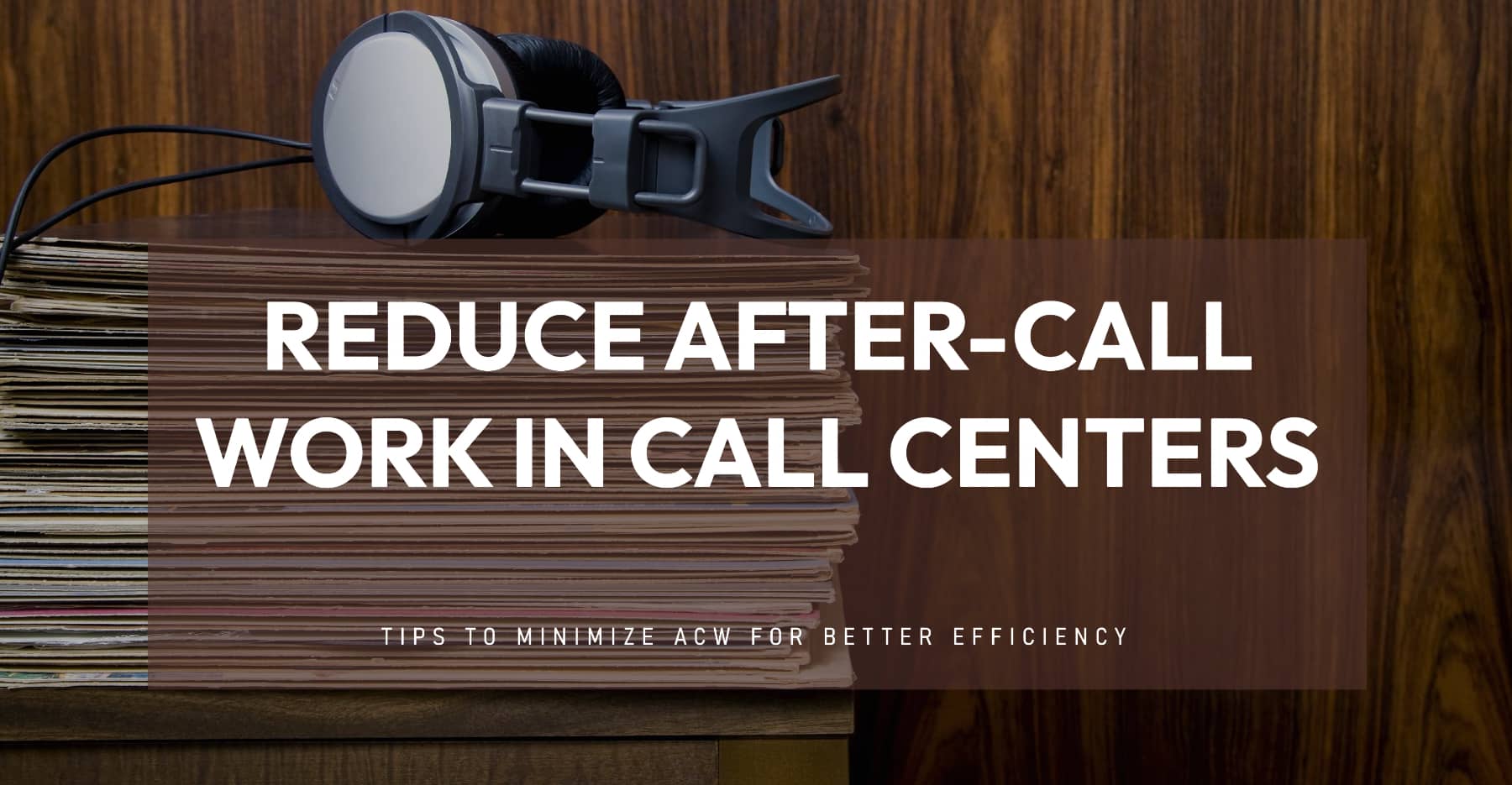After-Call Work (ACW), also known as wrap-up time or post-call processing, is a crucial aspect of call center operations that directly impacts agent performance, customer satisfaction, and overall operational efficiency. ACW refers to the set of tasks and activities that call center agents must complete after finishing a customer interaction, before moving on to the next call.
Why Is ACW Important?
ACW plays a vital role in ensuring a smooth and efficient customer experience. By dedicating time to perform necessary post-call activities, agents can:
Update customer information and call outcomes in the CRM system
Log call reasons, notes, and summaries for future reference
Schedule follow-up actions and communicate with other departments
Analyze customer feedback to identify areas for improvement
Effectively managing ACW is essential for call centers aiming to optimize their average handle time (AHT) and maintain high levels of customer satisfaction. The time agents spend on ACW directly contributes to AHT, which is a key performance indicator (KPI) for call centers.
Benefit of Optimizing ACW | Impact on Call Center Performance |
|---|---|
Reduced customer wait times | Improved customer satisfaction |
Increased agent productivity | Better operational efficiency |
Identification of process bottlenecks | Opportunities for process improvement |
Enhanced customer experience | Increased customer loyalty and retention |
As businesses strive to provide exceptional customer service while maximizing their resources, finding ways to streamline and reduce ACW has become a top priority. By leveraging AI assistance, automation, and best practices, call centers can significantly minimize ACW, allowing agents to focus on delivering high-quality customer service.
Why ACW Is Crucial For Call Centers
After-Call Work (ACW) is a critical component of call center operations that significantly impacts several key aspects of performance, including operational efficiency, agent performance, and customer satisfaction. Let's explore each of these areas in more detail.
Impact on Operational Efficiency
ACW directly affects a call center's operational efficiency by influencing the average handle time (AHT). AHT is a crucial metric that measures the total time an agent spends handling a customer interaction, including talk time, hold time, and ACW. By reducing ACW, call centers can minimize AHT and improve overall efficiency.
Aspect | Impact |
|---|---|
Reduced ACW time | Lower AHT |
Lower AHT | Increased operational efficiency |
Increased operational efficiency | Cost savings and better resource utilization |
Role in Improving Agent Performance and Productivity
Effective ACW management plays a vital role in enhancing agent performance and productivity. When agents have clear guidelines and efficient processes for handling post-call tasks, they can complete ACW quickly and move on to the next customer interaction. This leads to:
Increased agent capacity to handle more calls
Reduced idle time between calls
Improved agent morale and job satisfaction
Moreover, tracking ACW time helps identify agents who may require additional training or support to perform post-call tasks efficiently.
Effect on Customer Satisfaction and Experience
ACW also has a significant impact on customer satisfaction and experience. When agents complete post-call tasks effectively, it ensures that:
Customer information is accurately updated in the CRM system
Follow-up actions are scheduled and executed promptly
Customer feedback is analyzed and used for continuous improvement
By prioritizing ACW, call centers demonstrate their commitment to providing exceptional customer service and building long-term relationships with their clients.

Key Components of ACW
After-Call Work (ACW) consists of several essential tasks that agents must complete to ensure accurate record-keeping, efficient follow-up actions, and continuous improvement of customer service. Let's break down the key components of ACW.
Updating Customer Information and Call Outcomes in CRM
One of the primary tasks during ACW is updating customer information and call outcomes in the CRM system. This includes:
Verifying and updating customer contact details
Noting the reason for the call
Recording the resolution or next steps
Updating any relevant account information
Accurate CRM updates are crucial for maintaining a comprehensive view of the customer's history and ensuring seamless interactions in the future.
Logging Call Reasons, Notes, and Summaries
During ACW, agents should log detailed notes and summaries of the call, including:
Main reason for the customer's call
Key points discussed during the interaction
Any challenges or issues faced
Specific solutions or advice provided
These notes serve as a valuable reference for future interactions and help other agents quickly understand the context of previous conversations.
Scheduling Necessary Follow-Up Actions
Agents must also schedule any necessary follow-up actions during ACW. This may include:
Setting up a callback or email response
Escalating issues to higher-level support teams
Arranging for product returns or exchanges
Initiating refunds or compensation
By promptly scheduling follow-up actions, agents ensure that customer needs are met in a timely manner, improving customer satisfaction.
Communicating with Other Departments/Agents
In some cases, ACW may involve communicating with other departments or agents to resolve customer issues effectively. This could include:
Collaborating with technical support teams
Coordinating with billing or finance departments
Consulting with subject matter experts
Efficient communication during ACW helps streamline issue resolution and reduces the need for multiple customer interactions.
Analyzing Customer Feedback for Improvements
Finally, ACW presents an opportunity for agents to analyze customer feedback and identify areas for improvement. This may involve:
Reviewing customer survey responses
Assessing common pain points or frustrations
Identifying trends in customer preferences or needs
By regularly analyzing customer feedback, call centers can make data-driven decisions to enhance their products, services, and customer experience.
ACW Component | Benefits |
|---|---|
Updating CRM | Accurate customer records, seamless future interactions |
Logging notes and summaries | Valuable reference for future calls, context for other agents |
Scheduling follow-up actions | Timely issue resolution, improved customer satisfaction |
Communicating with other departments | Streamlined problem-solving, reduced need for multiple customer touchpoints |
Analyzing customer feedback | Data-driven improvements, enhanced customer experience |

Factors Affecting ACW Time
Several factors can influence the duration of After-Call Work (ACW) in a call center. Understanding these factors is crucial for identifying areas of improvement and implementing strategies to reduce ACW time. Let's explore the main factors affecting ACW time.
Industry and Sector-Specific Requirements
The industry or sector in which a call center operates can significantly impact ACW time. Some industries, such as healthcare or financial services, may require more extensive documentation and follow-up actions due to regulatory requirements or the complexity of customer issues. In contrast, industries like retail or e-commerce may have simpler ACW processes, resulting in shorter wrap-up times.
Complexity and Type of Customer Queries
The complexity and nature of customer queries can also affect ACW time. Straightforward inquiries or frequently asked questions may require minimal post-call work, while more complex or unique issues may demand extensive research, documentation, or collaboration with other departments.
Query Type | ACW Time |
|---|---|
Simple, frequent inquiries | Shorter ACW time |
Complex, unique issues | Longer ACW time |
Agent Skills, Experience, and Behavior
An agent's skills, experience, and behavior can play a significant role in determining ACW time. Factors include:
Proficiency with call center tools and systems
Familiarity with company products, services, and policies
Time management and multitasking abilities
Typing speed and accuracy
Attention to detail
Agents who possess strong skills and experience in these areas are likely to complete ACW tasks more efficiently, resulting in shorter wrap-up times.
Internal Processes and Policies
A call center's internal processes and policies can also impact ACW time. Factors to consider include:
Documentation requirements and templates
CRM system complexity and ease of use
Approval processes for certain actions (e.g., refunds or escalations)
Quality assurance and monitoring procedures
Streamlined, user-friendly processes and policies can help reduce ACW time, while cumbersome or outdated systems may prolong wrap-up times.
Availability of Knowledge Base and Technology
The availability of a comprehensive knowledge base and advanced technology can significantly influence ACW time. A well-organized, easily searchable knowledge base allows agents to quickly find relevant information, reducing the time spent on research during ACW.
Additionally, technologies such as AI-powered tools, automation, and CRM integrations can streamline ACW tasks, minimize manual data entry, and provide agents with real-time guidance and suggestions.

Benefits Of Tracking And Reducing ACW Time
Tracking and reducing After-Call Work (ACW) time offers numerous benefits for call centers, including improved agent efficiency, enhanced customer satisfaction, and better overall performance. Let's explore the key advantages of optimizing ACW time.
Increased Agent Efficiency and Productivity
By closely monitoring ACW time and implementing strategies to reduce it, call centers can significantly boost agent efficiency and productivity. When agents spend less time on post-call tasks, they can:
Handle more customer interactions throughout their shift
Reduce idle time between calls
Focus on providing high-quality customer service
Increased agent efficiency ultimately leads to better resource utilization and cost savings for the call center.
Reduced Customer Wait Times and Improved Satisfaction
Reducing ACW time directly impacts customer wait times and satisfaction. When agents complete post-call work quickly, they become available to assist new customers sooner. This leads to:
Shorter queue times for incoming calls
Faster issue resolution for customers
Increased overall customer satisfaction and loyalty
By minimizing customer wait times, call centers can provide a more positive customer experience and maintain a competitive edge in their industry.
Identification of Process Bottlenecks and Training Needs
Tracking ACW time helps call centers identify process bottlenecks and areas where agents may require additional training or support. By analyzing ACW data, managers can:
Pinpoint specific tasks or processes that consistently prolong ACW time
Identify agents who may benefit from targeted coaching or skill development
Optimize workflows and eliminate redundant or inefficient steps
Addressing these issues through process improvements and targeted agent training can significantly reduce ACW time and enhance overall call center performance.
Better Workforce Management and Staffing Optimization
Insight into ACW time trends and patterns allows call centers to make data-driven decisions regarding workforce management and staffing. By understanding the factors influencing ACW time, managers can:
Forecast staffing needs more accurately
Schedule agents based on their skills and efficiency
Ensure adequate coverage during peak hours or seasons
Effective workforce management and staffing optimization help reduce customer wait times, improve agent productivity, and maintain a high level of customer service.
Proactive Issue Resolution and Enhanced Customer Experience
By closely monitoring ACW time and regularly analyzing customer feedback, call centers can identify common issues or pain points that may prolong wrap-up times. This allows managers to:
Proactively address recurring customer concerns
Implement self-service options or knowledge base resources
Provide agents with targeted training on handling specific issue types
Proactive issue resolution not only reduces ACW time but also enhances the overall customer experience by addressing concerns before they escalate.
Benefit | Impact |
|---|---|
Increased agent efficiency | More customer interactions handled, better resource utilization |
Reduced customer wait times | Improved customer satisfaction and loyalty |
Identification of bottlenecks | Process improvements and targeted agent training |
Better workforce management | Accurate staffing, reduced wait times, maintained service levels |
Proactive issue resolution | Enhanced customer experience, reduced escalations |
Strategies To Reduce ACW Time
Reducing After-Call Work (ACW) time is crucial for optimizing call center performance and delivering exceptional customer service. Here are some effective strategies to minimize ACW time and boost agent productivity.
Implementing Contact Center AI and Automation
Integrating AI-powered tools and automation into your call center operations can significantly reduce ACW time. Consider implementing:
Automatic call transcription and summary generation: AI-powered tools can automatically transcribe calls and generate summaries, saving agents time on manual note-taking.
Real-time agent assistance: AI-based systems can provide agents with relevant information, knowledge base articles, or suggested actions during the call, reducing the need for extensive research during ACW.
CRM integrations: Automating data entry and updates between your call center software and CRM system can minimize manual work and reduce ACW time.
Streamlining Workflows and Internal Processes
Optimizing workflows and internal processes is another key strategy for reducing ACW time. Consider:
Simplifying documentation requirements and templates
Eliminating redundant steps or approvals
Providing agents with clear guidelines and decision-making authority
Regularly reviewing and updating processes based on agent feedback and performance data
Streamlined workflows enable agents to complete post-call tasks more efficiently, reducing ACW time and improving overall efficiency.
Providing Targeted Agent Training and Coaching
Investing in targeted agent training and coaching can significantly impact ACW time. Focus on:
Developing agents' proficiency with call center tools and systems
Enhancing their knowledge of products, services, and policies
Improving time management and multitasking skills
Providing feedback and coaching based on individual performance metrics
By equipping agents with the necessary skills and knowledge, call centers can empower them to handle ACW tasks more effectively and efficiently.
Using Call Scripts with ACW Prompts
Implementing call scripts with built-in ACW prompts can help guide agents through the post-call process and ensure consistency. Scripts should include:
Reminders to update customer information and call outcomes
Prompts to schedule follow-up actions
Guidance on categorizing and documenting issues
Tips for efficiently navigating tools and systems
Well-designed call scripts with ACW prompts can help reduce wrap-up time and minimize the risk of missed or incomplete post-call tasks.
Optimizing CRM and Other Tools for Quick Access
Ensuring that your CRM system and other call center tools are optimized for quick access and ease of use is crucial for reducing ACW time. Consider:
Customizing CRM layouts and fields to match your call center's specific needs
Implementing keyboard shortcuts and templates for common actions
Providing agents with multiple monitors to facilitate multitasking
Regularly gathering agent feedback on tool usability and making improvements
By optimizing your CRM and other tools, you can help agents complete ACW tasks more efficiently, reducing overall wrap-up time.
Monitoring ACW Metrics and Adjusting Processes Accordingly
Continuously monitoring ACW metrics and making data-driven adjustments to processes is essential for sustaining reduced ACW times. Regularly review:
Average ACW time per agent and team
Trends in ACW time by issue type or customer segment
Correlation between ACW time and other key performance indicators (KPIs)
Use these insights to identify areas for improvement, adjust processes, and provide targeted coaching to agents as needed.
Strategy | Key Tactics |
|---|---|
AI and Automation | Automatic call transcription, real-time assistance, CRM integrations |
Streamline Workflows | Simplify documentation, eliminate redundancies, provide clear guidelines |
Targeted Training | Develop tool proficiency, enhance product knowledge, improve time management |
Call Scripts | Include ACW prompts, reminders, and guidance |
Optimize Tools | Customize CRM layouts, implement shortcuts, gather user feedback |
Monitor Metrics | Track average ACW time, identify trends, make data-driven adjustments |
Role of AI In Optimizing ACW
Artificial Intelligence (AI) has revolutionized the way call centers operate, and its impact on After-Call Work (ACW) is no exception. By leveraging AI-powered tools and solutions, call centers can significantly optimize ACW processes, reduce wrap-up time, and enhance overall agent performance. Let's explore the various ways AI can help streamline ACW.
Automatic Call Transcription and Summary Generation
One of the most significant benefits of AI in ACW optimization is its ability to automatically transcribe calls and generate summaries. AI-powered speech recognition and natural language processing (NLP) technologies can:
Convert spoken conversations into written text in real-time
Identify key points, action items, and customer sentiment
Generate concise call summaries for easy reference and analysis
By automating call transcription and summary generation, AI eliminates the need for manual note-taking, saving agents valuable time during ACW.
Real-Time Agent Assistance and Knowledge Base Suggestions
AI-powered tools can provide agents with real-time assistance and relevant knowledge base suggestions during calls. These tools can:
Monitor the conversation and identify customer issues or questions
Quickly search the knowledge base for relevant articles or solutions
Display suggested responses or actions to the agent in real-time
Real-time AI assistance helps agents resolve customer queries more efficiently, reducing the need for extensive research during ACW and ultimately shortening wrap-up times.
Sentiment Analysis and Customer Feedback Processing
AI-powered sentiment analysis tools can help call centers gain valuable insights from customer interactions and feedback. These tools can:
Analyze customer sentiment based on speech patterns, tone, and language
Identify common issues, pain points, or positive experiences
Categorize and prioritize customer feedback for action
By automating sentiment analysis and feedback processing, AI enables call centers to quickly identify areas for improvement, address customer concerns proactively, and optimize ACW processes based on data-driven insights.
Integration with CRM for Faster Data Updates and Task Assignment
AI can also facilitate seamless integration between call center software and Customer Relationship Management (CRM) systems. AI-powered integrations can:
Automatically update customer records with call details and outcomes
Assign follow-up tasks to appropriate agents or departments based on predefined rules
Trigger automated workflows or notifications based on specific call criteria
By streamlining data updates and task assignments through AI-powered CRM integrations, call centers can significantly reduce manual effort during ACW, allowing agents to focus on more value-added activities.
AI Application | Benefits |
|---|---|
Automatic Call Transcription | Eliminates manual note-taking, saves time |
Real-Time Agent Assistance | Provides relevant information, reduces research time |
Sentiment Analysis | Identifies customer pain points, enables proactive problem-solving |
CRM Integration | Automates data updates, streamlines task assignments |
Implementing AI in ACW optimization requires careful planning, selection of the right tools, and effective change management. Call centers should:
Assess their current ACW processes and identify areas where AI can provide the most value
Evaluate and select AI-powered solutions that align with their specific needs and integrate well with existing systems
Provide agents with adequate training on how to leverage AI tools effectively
Continuously monitor and refine AI implementations based on performance metrics and agent feedback

Best Practices For Managing ACW
Effectively managing After-Call Work (ACW) is crucial for maintaining a high-performing call center that consistently delivers excellent customer service. By implementing best practices and fostering a culture of continuous improvement, call centers can optimize ACW processes, reduce wrap-up time, and boost overall efficiency. Let's explore some key best practices for managing ACW.
Setting Realistic ACW Targets and Monitoring Adherence
Establishing realistic ACW targets is essential for ensuring that agents have sufficient time to complete necessary post-call tasks without compromising quality or accuracy. When setting ACW targets, consider:
Industry benchmarks and the complexity of your call center's services
Historical ACW data and trends specific to your organization
Input from experienced agents and supervisors
Once targets are set, regularly monitor adherence to these goals and provide agents with feedback and coaching as needed to help them meet these objectives.
Encouraging Agents to Update CRM During Calls When Possible
Whenever possible, encourage agents to update the Customer Relationship Management (CRM) system during the call itself. This can include:
Verifying and updating customer contact information
Logging call reasons and key discussion points
Noting any immediate follow-up actions or resolutions
By updating the CRM during the call, agents can reduce the amount of work required during ACW, ultimately shortening wrap-up times.
Using Shortcuts, Templates, and Knowledge Base for Efficiency
Provide agents with tools and resources that can help them complete ACW tasks more efficiently. These may include:
Keyboard shortcuts for common actions or frequently used fields
Templates for call summaries, email responses, or follow-up tasks
A well-organized, searchable knowledge base with relevant articles and solutions
By equipping agents with these efficiency-boosting tools, call centers can help reduce ACW time while maintaining high-quality output.
Seeking Regular Agent Feedback for Process Improvements
Actively seek feedback from agents on ACW processes and tools. Agents are on the front lines of customer interactions and often have valuable insights into areas for improvement. Consider:
Conducting regular surveys or focus groups to gather agent feedback
Encouraging open communication and idea-sharing among team members
Implementing a formal process for agents to suggest process improvements
By involving agents in the continuous improvement of ACW processes, call centers can identify and address pain points, optimize workflows, and foster a sense of ownership and engagement among team members.
Balancing Speed and Accuracy in ACW Documentation
While reducing ACW time is a key objective, it's crucial to maintain a balance between speed and accuracy in post-call documentation. Emphasize the importance of:
Capturing all essential information and details
Ensuring clarity and completeness in call summaries and notes
Double-checking data entries and updates for accuracy
Encourage agents to prioritize quality and thoroughness in their ACW documentation, even if it may take a bit more time. Accurate and comprehensive call records are essential for providing seamless customer experiences and enabling data-driven decision-making.
Best Practice | Key Tactics |
|---|---|
Set Realistic Targets | Consider industry benchmarks, historical data, and agent input |
Update CRM During Calls | Verify information, log call reasons, note immediate actions |
Use Efficiency Tools | Provide shortcuts, templates, and a searchable knowledge base |
Seek Agent Feedback | Conduct surveys, encourage idea-sharing, implement a suggestion process |
Balance Speed and Accuracy | Emphasize capturing essential details, ensure clarity and completeness |
Mastering After-Call Work for Exceptional Customer Service
After-Call Work (ACW) is a critical component of call center operations that directly impacts agent performance, customer satisfaction, and overall efficiency. By understanding the key components of ACW, factors affecting wrap-up time, and the benefits of reducing it, call centers can implement targeted strategies to optimize their processes and deliver exceptional customer experiences.
Leveraging the power of AI, automation, and best practices such as setting realistic targets, encouraging in-call CRM updates, and seeking agent feedback can significantly reduce ACW time. However, it's essential to maintain a balance between speed and accuracy in post-call documentation to ensure comprehensive and accurate call records.
Effective ACW management requires ongoing monitoring, analysis, and refinement. By continuously tracking ACW metrics, identifying areas for improvement, and adapting processes based on data-driven insights, call centers can foster a culture of continuous improvement and maintain a competitive edge in their industry.
Ultimately, mastering ACW is not just about reducing wrap-up time; it's about empowering agents to deliver the highest quality of service to customers. By equipping agents with the right tools, training, and support, call centers can create a win-win situation where both agent efficiency and customer satisfaction thrive.


